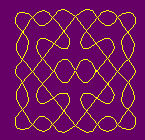![]()
This page is under construction
Their symmetry is distinguished by Paulus Gerdes, discussing so-called mirror curves resulting from knot and link sand drawings from Lunda region (Eastern Angola and Northwestern Zambia). If we have a some polyomino in a regular plane tiling, with the set of (two-sided) mirrors incident to the edges or perpendicular in their midpoints, the ray of light starting from such midpoint, after series of reflections will return to it, forming a closed path: a mirror curve. If the polyomino is completely covered by a singular curve, it always represents a knot projection; otherwise, if it is exhausted by several components, it is a link projection. The drawing will be symmetrical or asymmetrical, depending on the placement of internal mirrors, so the symmetry is not a necessary property of mirror-curves. Anyway, they possess the other remarkable property: the modularity. The possibilities for the modular design of such structures are unlimited. The variety could be obtained by using topological variations of the prototiles, but also if we use different basic polyominoes, resulting from Archimedean (uniform) plane tilings.
Analyzing mirror-curves, Gerdes discovered Lunda designs: if the successive smaller squares through which the curve passes are colored in a color-alternating manner (black-white), we obtain the black-and-white mosaic. Such designs possess the local equilibrium property: each edge-midpoint is equally surrounded by black and white small squares. Certainly, from the local equilibrium results the global equilibrium in every row and in every column. Every square Lunda design is a modular black-and-white design, formed by only three kinds of prototiles (two kinds of internal and one kind of border prototiles).
|
|
|
One section of Zaslavsky (1973a, 105-109) was dedicated to networks, based on Torday's information (1925) on the Bushongo (actual Zaire) and Bastin's study (1961) of decorative art of the Tchokwe (Angola) (For educational use of Zaslavsky's analysis of the Bushongo networks, see NCTM (1984) and Whitcombe & Donaldson (1988)). She had not had access to the ethnographical information on such networks published by Baumann (1935, 222-223), Hamelberger (1952) and Dos Santos (1961). Since the publication of "Africa Counts" large ethnographical collections of networks have become available: Pearson (1977: 'sandgraphs' observed in the 1920s in the Kwandu-Kuvanga and Muxiku provinces of Angola); Fontinha (1983: 'sona' or 'sanddrawings' collected principally among the Tchokwe of northeastern Angola during the 1940s and 1950s); and Kubik (1986, 1987a, 1987b, 1988: networks observed among the (Va)luchazi in northwestern Zambia during the 1970s). In order to facilitate the memorisation of their standardised 'sona', the drawing experts used the following mnemonic device. After cleaning and smoothing the ground, they first set out with their fingertips an orthogonal net of equidistant points. Now one or more lines are drawn that 'embrace' the points of the reference frame. By applying their method the drawing experts reduce the memorisation of a whole drawing to that of mostly two numbers (the dimensions of the reference frame) and a geometric algorithm (the rule of how to draw the embracing line(s)). Most drawings belong to a long tradition (cf. Redinha, 1948). They refer to proverbs, fables, games, riddles, animals, etc. and play an important role in the transmission of knowledge and wisdom from one generation to the next. In Kubik's view the 'sona' "transmit empirical mathematical knowledge" (1987a, 450). The geometry of the 'sona' is a "non-euclidean geometry": "The forefathers of the Eastern Angolan peoples discovered higher mathematics and a non-Euclidian geometry on an empirical basis applying their insights to the invention of these unique configurations" (Kubik, 1987b, 108). He calls attention to the symmetry of many 'sona', the implicit rules for construction and rules for anchoring figures of the same type. The ethnographical publications of collections of 'sona' drew the attention of mathematicians. Ascher and Gerdes conducted research on the 'sona', independently one of another. Ascher's study (1988, 1991) deals with geometrical and topological aspects of 'sona', in particular, with symmetries, extension, enlargement through repetition, and isomorphy. Gerdes (1989a, 120-189) analyses symmetry and monolinearity (i.e. a whole figure is made up of only one line) as cultural values, classes of 'sona' and corresponding geometrical algorithms for their construction, systematic construction of monolinear groundpatterns, chain and elimination rules for the construction of monolinear 'sona'. It is suggested that the 'drawing experts' who invented these rules probably knew why they are valid, i.e. they could prove in one or another way the truth of the theorems that these rules express. He advances also with the reconstruction of lost symmetries and monolinearities by means of an analysis of possible drawing errors in reported 'sona' (for an introductory summary of his research findings, see: Gerdes, 1990d, 1991d and 1991e). Inspired by his historical research findings, Gerdes experimented with possibilities to use the 'sona' in mathematics education, in order to value and revive a rich scientific tradition that had been vanishing (Cf. Gerdes, 1988a, b; 1989a, b, c; 1990a; 1991a and g; cf. Ratteray, 1991). He also initiated a mathematical exploration of the properties of some (extended) classes of 'sona' (see Gerdes, 1989a, 288-297). In a similar way, Kubik's research stimulated a mathematical investigation by Jaritz on a particular class of 'sona' (1983).
For more see:
Uncovering 'hidden' mathematical ideas: geometrical form
Networks, graphs or 'sanddrawings'

BACK TO THE ANCIENTS
![]()
Since opening 5/25/97, Mr.
Web Counter says:
visitors to
![]()
These web pages are brought to
you by
The Mathematics Department of
The State University of New York at Buffalo
created and maintained by Dr. Scott W. Williams, Professor of Mathematics